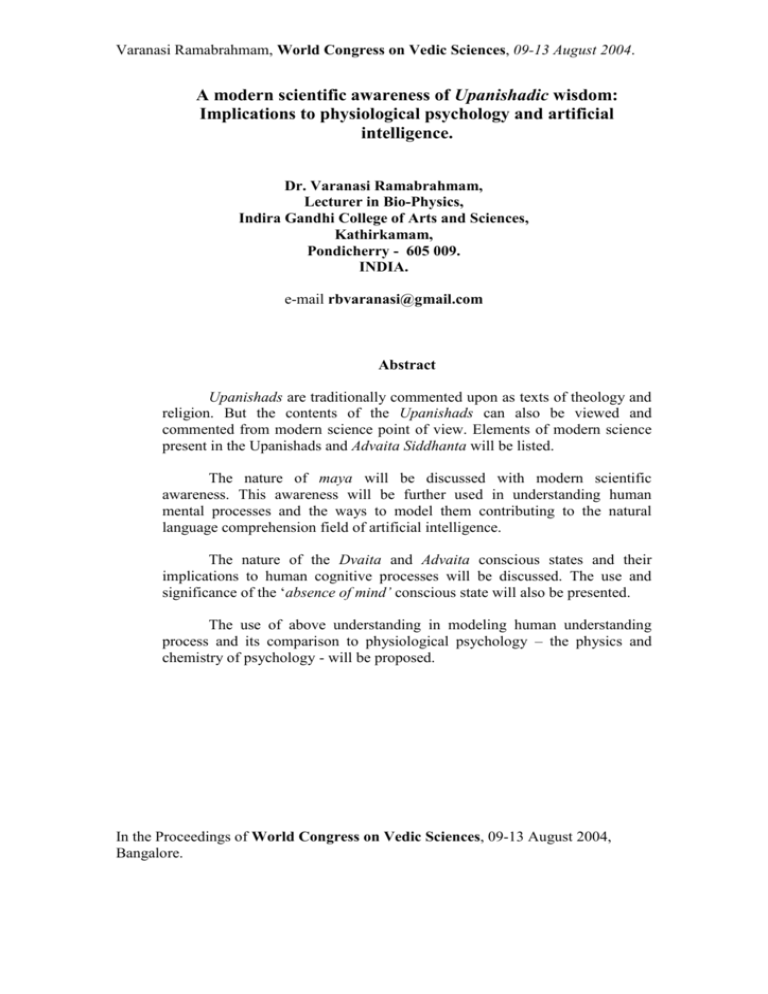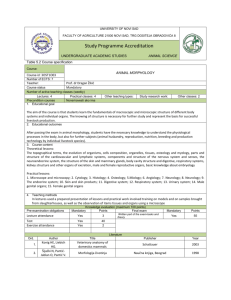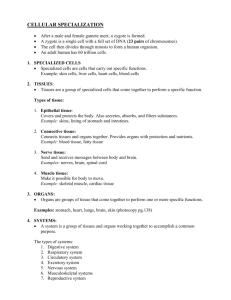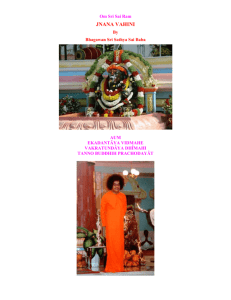Implications to physiological psychology and artificial
advertisement

Varanasi Ramabrahmam, World Congress on Vedic Sciences, 09-13 August 2004. A modern scientific awareness of Upanishadic wisdom: Implications to physiological psychology and artificial intelligence. Dr. Varanasi Ramabrahmam, Lecturer in Bio-Physics, Indira Gandhi College of Arts and Sciences, Kathirkamam, Pondicherry - 605 009. INDIA. e-mail rbvaranasi@gmail.com Abstract Upanishads are traditionally commented upon as texts of theology and religion. But the contents of the Upanishads can also be viewed and commented from modern science point of view. Elements of modern science present in the Upanishads and Advaita Siddhanta will be listed. The nature of maya will be discussed with modern scientific awareness. This awareness will be further used in understanding human mental processes and the ways to model them contributing to the natural language comprehension field of artificial intelligence. The nature of the Dvaita and Advaita conscious states and their implications to human cognitive processes will be discussed. The use and significance of the ‘absence of mind’ conscious state will also be presented. The use of above understanding in modeling human understanding process and its comparison to physiological psychology – the physics and chemistry of psychology - will be proposed. In the Proceedings of World Congress on Vedic Sciences, 09-13 August 2004, Bangalore. Varanasi Ramabrahmam, World Congress on Vedic Sciences, 09-13 August 2004. The Upanishads are treasure-houses of ancient Indian wisdom. Together with the Brahma Sutras and the Bhagawatgita, Upanishads have been traditionally commented upon theologically and are considered as texts of religion. Thus we have Advaita view revived by Sankara, Visistadvaita view of Ramanuja, Dvaita view of Madhwa and the Saktadvaita view as chief and popular views and sects are created around each of them. Vedanta Darsana and Advaita Siddhanta have their roots in the Upanishads. Advaita philosophy nurtured and developed by Vedanta and Sabdabrahma Theory of Patanjali can be usefully viewed as understandings of integrated psychology and natural language processing and hence can be interpreted from modern science point of view. As is known psychology is physiology and physiology is study of physico-chemical processes in the organism. Such a view reveals the scientific content of the Upanishadic wisdom. This mine of knowledge can be beneficially applied to the modern scientific disciplines like physiological psychology and artificial intelligence. Upanishads propose the existence of Atma and are source books of Atma jnana. Atma jnana when studied with an open mind with concentration and further contemplated deeply, it becomes evident that Atma jnana is the software dealing with the structure, origin, function, cessation and control of mind in the four conscious states in which mind functions and ceases to function (concept diagram I). Atma jnana also provides us with the details of the source of psychic or mental energy and mental time-space. The changes and transformation of psychic wave 2 Varanasi Ramabrahmam, World Congress on Vedic Sciences, 09-13 August 2004. energy pulses issuing out of Atma (the Bio-oscillator, which generates psychic energy pulses) enable us to know, to perceive, to understand, experience and be aware of all these processes, Atma guiding and controlling them without itself ever changing. (concept diagrams II, III, and IV) Table I gives the psychological and scientific meanings of famous Upanishadic Mahavakyas. Formation of Inner- world (prapancham) From Atma---the Sat – Chit – Ananda,- a bio-oscillator –which is the result of the breathing process - the psychic energy generator – psychic energy pulses issue out and get reflected in Medha as ‘maya’. Atma with its characteristic as Sat gives us the ability to be conscious of our body, ourselves, within and without of us. With its characteristic as Chit gives us the ability to know, to perceive, to think and as Ananda to experience , to understand, to know the meanings and as Sat-Chit-Ananda gives us the ability to be aware of all these. If we are involved in these, we are jivatma and if we witness these as a seer uninvolved and hence unaffected, we are paramatma. The reflected chit - sakti pulse series in Medha termed as maya are virtual (mithya) but are same in form and nature as the real chit- sakti. Maya is also known as Chit Abhasa(reflected chit) or Pranavam (primordial sound) Maya is the current of awareness pervading the whole body. Maya bifurcates (first transformation or change) into ‘Divya’ and ‘Swara’. Divya is jnana sakti – 3 Varanasi Ramabrahmam, World Congress on Vedic Sciences, 09-13 August 2004. electro- chemical energy – which gets divided into four antahkaranas (inner tools) as – manas, buddhi, chittam, and ahamkaram. ‘Swara’ is the prana sakti (mechanical energy) which divides itself into pancha pranas – prana, apana, vyana, udana, and samana. Jnana sakti as manas activates sense organs and prana sakti activates action organs to do respective functions (concept diagrams II and III). From these diagrams we know that mind is a combined operation of Atma, maya, antahkaranas, panchapranas, sense organs and action organs. Also mental functions are reversible transformations of chit – energy pulses in mental time- space (awareness of mind). Thus the nature and mode of these energy transformations can be easily understood by using concepts in Physics, Electronics and Communication engineering. Physics is a natural science which deals with actions and interactions concerning matter and energy in Time and Space. Thus the above- cited mental functions can be probed into and understood in terms of matter (bio-materials such as proteins, neurons) and energy (chit-energy - electrochemical energy pulses) in the mind- transcending awareness (time - space – the energy presence) in the bodyspace. Also concepts developed and used in electronics and communication engineering disciplines can be used to understand and propose a model blockdiagram regarding mental functions – creation and retrieval of inner –world (prapancham), experiences (vasanas, meanings, understandings), that help us to know / perceive (think) / experience /understand or cognize and cognition- related happenings that take place during our learnings of all kinds (concept diagrams IV, VA,VB) the normal knowledges, language learnings, and discipline- related knowledges. 4 Varanasi Ramabrahmam, World Congress on Vedic Sciences, 09-13 August 2004. In this scheme of understanding, when knowing takes place through sense organs, the input energy forms become aware to the mind through manas. Manas is modulated chit-energy pulse in accordance with input energy form sensed by sense organs. Mind knows through manas, records through manas and retrieves through manas the cognitions. Manas is the medium of knowing. The experiences caused by the cognitions are sensed, stored and retrieved by chittam simultaneous to knowing. Knowing and experiencing are done so quickly to give an impression that they happened simultaneously. When we receive information other than in the language we are familiar with, we do not know anything. Because the process of knowing getting converted into perception, experience / understanding to meaningful experience or experienced meaning does not and cannot take place for want of prior knowledge of the language. Experiences caused by cognitions are called vasanas. These include the meanings of the words we learn by learning the languages through sense organs(eye, ear) and action organs(hand movement, writing). All the skills we learn using sense and action organs simultaneously. Thus all learnings including languages, disciplines, and skills are happening by the simultaneous action of Jagrat(awakened) and Swapna(dream) conscious states in which the mind alternates between Advaita and Dvaita conscious states. Dvaita state is the state of knowing, perception, experiencing, understanding, and Advita state is meaningful experience and experienced meaning state. In the interplay of these conscious states the Chit-abhasa energy pulse undergoes modulation in the expresser and demodulations consecutively in the 5 Varanasi Ramabrahmam, World Congress on Vedic Sciences, 09-13 August 2004. receiver to give us knowledge, perceptions, experiences, understandings, meanings and skills in the simultaneous use of Atma(awareness) Maya(current of awareness flowing throughout the body), antahkarnas, pancha pranas, sense organs and action organs. Simply putting, our mental functions are the transformations of chit-abhasa pulses, modulated by energies through sense organs and the stored informations as potential energies retrieved (Vasanas first and then Prapancham) and demodulated to give us knowledge, experiences etc. Cognitions by sense organs are mental processes of human beings and to a less extent, of animals (all the vertebrates which breathe and have spinal chord). Several branches of learning take study of mental processes as one of their subject matters: epistemology, psychology, physiological psychology, neurology, artificial intelligence and cognitive sciences contribute to the study of the mental processes in their own way. Up to now, however, little has bean done to combine the approach- let us say – of the physiological psychologists and neurologists who see cognitive process as a biochemical and biophysical energy transformation with the proponents of Connectionism, who have a lot to say on pattern – recognition, memory and learning. Most of the present attempts aim at modeling machine thinking as an isolated process which is the result of sensing. But if human mental processes are observed, it becomes obvious that thinking is but an intermediary process which transforms 6 Varanasi Ramabrahmam, World Congress on Vedic Sciences, 09-13 August 2004. sensing into sense and sense into utterance/ expression. Human mental process can be stated sequentially as follows. 1. Sensing through sense organs (knowing). 2. Perception (thinking, reasoning, correlation with already available cognitive data in the brain). 3. Experience / Understanding 4. In the mental time- space. Thus human mental process is generally held to be a combination and quick successive transformation of following four modes. Speaker: 1. In mental awareness. 2. Experiencing / Understanding. 3. Perception. 4. Utterance /Expression. Listener: 1. In mental awareness.2. Knowing (through sense organs) 3. Perceiving 4. Experiencing / Understanding Language, the chief communication tool of human beings in day to day transactions and also in learnings, understandings and imparting various disciplines and skills, is learnt consciously or otherwise through these four modes.. Human cognitive processes, especially understanding is defined by many proponents of connectionism as a kind of mapping .It will be interesting if due attention were paid to the relevant data of physics – energy and its transformations – 7 Varanasi Ramabrahmam, World Congress on Vedic Sciences, 09-13 August 2004. coupled with the insight of Upanishads presented here and it will play a vital role in understanding and modeling human – cognitive processes. Sabdabrahma theory of Indian grammarians is highly significant in this regard. Sabdabrahma theory names four modes of mental processes as – Para(awareness), Pasyanti(understanding / meaning/experience), Madhyama(perception) and Vaikhari (utterance/expression) when language is learnt or spoken. Sabdabrahma theory has Advaita philosophy as its basis. As is discussed here, Advaita philosophy is an integrated psychology which professes the sameness of knower and known in knowing by concerning with BEING and BECOMING in forward and reverse directions. Cognitive sciences often rediscover philosophical analyses painstakingly. A better policy would be first to learn what Upanishadic wisdom teaches us in this regard and then move on to experimentation and model – building within the scope of positive science. The aim of this research paper is the presentation of the possibility to develop software which would perform the tasks of the standard connectionist models using Upanishadic wisdom. Application of Upanishadic wisdom helps in clearing conceptual issues to reach the stage of extending connectionist model and translating the software into physiological modeling for which the study of bio-chemicals such as proteins will be useful. TABLE I PSYCHOLOGICAL AND SCIENTIFIC MEANINGS OF CHIEF UPANISHADIC MAHAVAKYAS 8 Varanasi Ramabrahmam, World Congress on Vedic Sciences, 09-13 August 2004. 1. Aham Brahma Asmi The real identity of ‘I’ is Unoccupied Awareness. ‘I’ is not a person, thought or not a sense. ‘I’ is pure (transcending self – consciousness) Consciousness or Divine Consciousness. ‘I’ is the impersonal Seer which is the source of mental energy and guide of and witness to transformation of mental energy as mental functions but unaffected by them and transcending both mental functions and their cessation. 2. Tat Tvam Asi Self and Divine Consciousnesses are same in nature, content, structure, form (function) and presence. At a given moment either self-consciousness or Divine consciousness will be present. Self-consciousness is super imposition over divine consciousness. Divine consciousness is eternal, self-consciousness is transient. 3. Ayam Atma Brahma Atma is Brahma – Unoccupied Awareness – Divine Consciousness - Energy Presence without transformation. 4. Prajnanam Brahma Brahma – as Atma – Bio-oscillator – Energy Presence – is Mental TimeSpace. (Prajnanam) is Unoccupied Awareness in Divine Consciousness. 5. Raso vy Saha Experience of Essence of the meaning of Maha vakyas, - All Cognition-related experiences in the awareness of the Self - Meaningful Experience. Silence. Peace. Bliss. Experienced meaning. Purport. 6. Anando Brahma Unoccupied Awareness is bliss. 7. Sarvam Khalu Idam Brahma All the world (collections of cognitions sensed by sense organs through the medium of Manas) – is composed in, made up of, sustained by, rests in and ceases to be because of and part and parcel of Psychic energy pulse generator – Atma. CONCEPT DIAGRAM I 9 Varanasi Ramabrahmam, World Congress on Vedic Sciences, 09-13 August 2004. STATES OF CONSCIOUSNESS – MENTAL TIME - SPACE JAGRAT SUSHUPTI SUSHUPTI ATMA Mind is present if willed. Sense and action organs are alert and ready to function. Through Meditation one reaches this state. Also known as State of Visranta Drishti, Silence, Bliss, Peace, Unoccupied awareness, Pure consciousness Divine consciousness Real ‘I’ state etc. MAYA MIND (divyam & swaram) Antahkaranas Panchapranas Sense Organs Jnanendriyas Action Organs Karmendriyas JAGRAT Mind is present, Sense and Action organs are active are in working state. All learnings take place in this state. Meditation starts in this state. Also known as Bahirmukha Dristi state. Mind is absorbed in Maya.Sense and action organs are not in functional state. No awareness of without or within Cognitions (prapancham) or Vasanas. Also known as Pralayam state. SWAPNA Mind is present. Sense organs are in dormant state. Actions organs will be functioning if necessary. Meditation becomes one-pointed in this state. Also known as Anthramukha Dristi state. CONCEPT DIAGRAM II 10 Varanasi Ramabrahmam, World Congress on Vedic Sciences, 09-13 August 2004. ARCHITECTURE OF MIND AS EXPRESSED IN THE UPANISHADS SAT-CHIT-ANANDA ATMA BIO OSCILLATOR Generator of psychic energy pulses Awareness Source of mental energy/mental time-space MAYA OR CHIDABHASA OR PRANAVAM Virtual chit – energy Pulses MIND DIVYAM-Jnanasakti SWARAM-Prana Sakti Antahkaranas Pancha Pranas Manas – Perception – Recording & Recollection of cognitions. Buddhi - Intellectual functions Chittam – Cognition created Experience/Meaning Understanding Recording & Recollection Ahamkaram – Self-consciousness Prana,Apana,Vyana, Udana,Samana Karmendriyas -Action Organs-Movements of -Leg, Hand, Vocal Chords, Reproductive organ, Bowels. MANAS REACTION ACCORDING TO SENSING OR KNOWLEDGE OR PERCEPTION OR THOUGHT OR URGES Jnanendriyas – eyes, ear, nose, Tongue, skin – sense organs Mind is a combined operation of all these 11 Varanasi Ramabrahmam, World Congress on Vedic Sciences, 09-13 August 2004. CONCEPT DIAGRAM III ATMA Jagrat Sushupti Bhakti MAYA maya not transformed Transformation PHASE OF CESSATION OF Sushupti of Maya MENTAL FUNCTIONS ANTAHKARANAS Tools to gain Knowledge PANCHA PRANAS CHITTAM MANAS Knowing Outside world Sense Organs Outside objects Action Organs Actions or Reactions Remembrance Forgetfulness 1. Object-Experiences collection and recollection 2. Sentence meaning recording & recollection Awareness of individual – related emotions Decision Making Thought Perception Volition Reasoning Inner-world (Prapancham) Consciousness of Body and Character etcc., Logic (Collection of Known Objects) BUDDHI AHAMKARAM INTELLECT Learning, Teaching, Knowing, Forgetting etc. Vibhakti 12 Varanasi Ramabrahmam, World Congress on Vedic Sciences, 09-13 August 2004. CONCEPT DIAGRAM IV ARCHITECTURE OF FUNCTION OF MIND DURING LEARNING/KNOWING TEACHING/EXPRESSING ATMA Bhakti State MAYA Jagrat Sushupti Advaita State Unoccupied awareness OBJECT-FREE EXPERIENCE Knower-Known free Consciousness state. MIND Pure Consciousness Sushupti JNANA SAKTI Avyakta State. State of Self. Silence. Peace. Bliss. PRANA SAKTI PANCHA PRANAS ACTION ORGANS Speech Movement of leg Movement of hand Movement of Bowels Movement of Reproductive organ ANTAHKARANAS AHAMKARAM BUDDHI CHITTAM MANAS Logic Decision Making Senses, Consciousness of experiences caused by cognitions Intellectual Remembering EYE-light energy Operations Forgetting Intuitions Meanings, Understandings EAR- Sound energy NOSE-Chemical energy TONGUE-Chemical energy SKIN- Mechanical & Heat energy (ACTIONS OR Consciousness of Body , Mind Personality & Social Status SENSE ORGANS REACTIONS----MECHANICAL ENERGY) THOUGHT SELF-CONSCIOUSNESS OF INNER WORLD Inner-World -Collection of Known Objects VYAKTA STATE, JAGRAT CONSCIOUS STATE, LEARNING & TEACHINGSTATE, STATE OF THOUGHTS, STATE OF SELF-CONSCIOUSNESS, VIBHAKTI STATE. DVAITA STATE, KNOWER - KNOWN CONSCIOUSNESS STATE Interplay of Advaita – Dvaita mental states and Jagrut (awakened) and Swapna (dream) conscious states OBJECT: A thing, person or idea (in a sensible/perceivable energy form). 13 S w a p n a C o n s c i o u s s t a t e s Varanasi Ramabrahmam, World Congress on Vedic Sciences, 09-13 August 2004. 14 Varanasi Ramabrahmam, World Congress on Vedic Sciences, 09-13 August 2004. S R E S T H A B R E A T H I N G P R A P N R A O C E S S CONCEPT DIAGRAM V A FUNCTION OF MIND ACCORDING TO UPANISHADS Wakeful Sleep – JAGRAT SUSHUPTI (Advaita Consciousness State) B I O O S C I L L A T O R p r a p a n c h a m Mind Absorbed – SUSHUPTI T (Deep Sleep State) r Awareness Sat- Chita Electro Ananda n Maya Dristi Chemical s Pranavam Energy Atma Medha d Chit COGNIu TIONS c Sakti Chit Manas e Abhasa Samvit Real Virtual r Source Source Para DIVYAM Mechanical Energy BHAKTI Vibhakti Prana Sakti Action Jagat MIND SWARAM Transducer Organ s Manas Chittam Buddhi Madhyama Pasyanti Memory Inner world -Collection of cognitions Ahamkaram (Self consciousness) Potential Energy form (Jada) Intellectual Operations Vasanas Light Energy Eye Ear Nose Tongue Skin Forms, Scenes Mechanical Energy Sound s Chemical l Energy Chemical l Energy Smells Mechanical & Heat Energy Touch Tastes Movements of Vocal Chords - Speech Hand - related Cognition- related Experiences, meanings, Understandings, Senses, Intuitions ( Maitra Jnana – Acquired Knowledge) Reproductive Organ - related Genetically in-built urges, senses, Intuitions (Varuna Jnana), Volitions Bowels related Leg - related Potential Energy form (Jada) Awakened State – JAGRAT (Dvaita Consciousness State) SWAPNA (Dream State) Varanasi Ramabrahmam, World Congress on Vedic Sciences, 09-13 August 2004. Concept Diagram V B - BIONICS OF KNOWING/LEARNING-EXPRESSING/TEACHING S R E S T H A P R A N A B R E A T H I N G MIND ABSORBED Atma Awareness Maya Continous Awareness DRISTI Psychic Energy Pulses Reflected satvirtual chit energy pulses First transformation Modulation Object Energy Forms ( Light, Sound, chemical, mechanical, heat) Perception Demodulation Transformation - I Knowing Sense Organs Expression BEING Experienced Meaning Meaningful experience Sat-chit-Ananda BHAKTI (Tatpara, Tatparya) P R O C E S S Para Transducer Vaikhari Transducer Action Organs’ Movements Utterance Vasanas Chittam Pasyanti Activated Vasanas Experiences, SubjectObject free verb state (infinite or present continuous form) State of faith, intuition and understanding I – Sense, Volitions Manas Vibhakti Jagat Madhyama Thoughts Subject-verb-object state Knower-knowing-known state I - thought Jada – Potential energy form Transformation II Demodulation Prapancham Jada – Potential Energy form Modulation Second Transformation Intellectual Operations 2 Modulation BECOMING Buddhi MIND ACTIVE VIVARTANAM Reversible Change Demodulation









